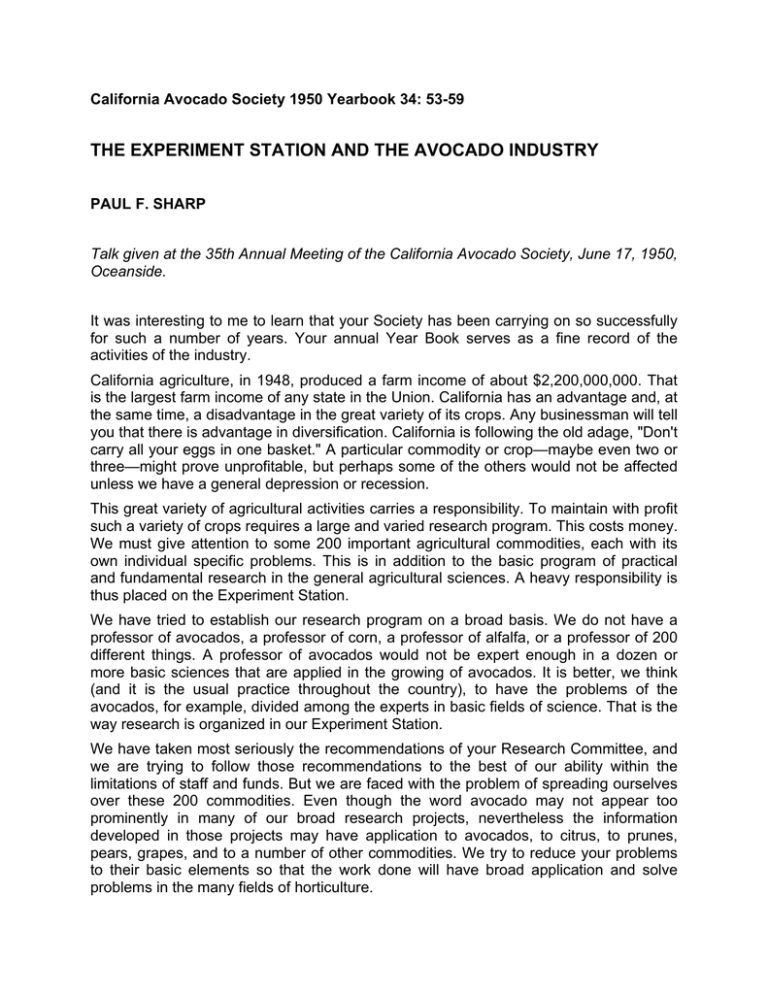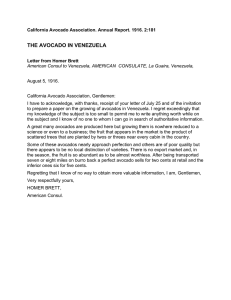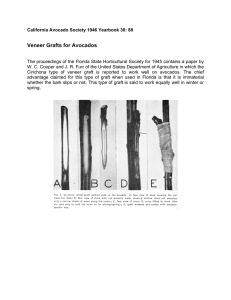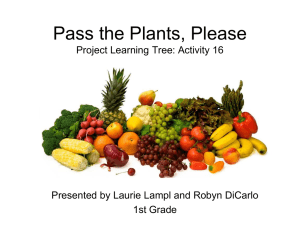THE EXPERIMENT STATION AND THE AVOCADO INDUSTRY
advertisement

California Avocado Society 1950 Yearbook 34: 53-59 THE EXPERIMENT STATION AND THE AVOCADO INDUSTRY PAUL F. SHARP Talk given at the 35th Annual Meeting of the California Avocado Society, June 17, 1950, Oceanside. It was interesting to me to learn that your Society has been carrying on so successfully for such a number of years. Your annual Year Book serves as a fine record of the activities of the industry. California agriculture, in 1948, produced a farm income of about $2,200,000,000. That is the largest farm income of any state in the Union. California has an advantage and, at the same time, a disadvantage in the great variety of its crops. Any businessman will tell you that there is advantage in diversification. California is following the old adage, "Don't carry all your eggs in one basket." A particular commodity or crop—maybe even two or three—might prove unprofitable, but perhaps some of the others would not be affected unless we have a general depression or recession. This great variety of agricultural activities carries a responsibility. To maintain with profit such a variety of crops requires a large and varied research program. This costs money. We must give attention to some 200 important agricultural commodities, each with its own individual specific problems. This is in addition to the basic program of practical and fundamental research in the general agricultural sciences. A heavy responsibility is thus placed on the Experiment Station. We have tried to establish our research program on a broad basis. We do not have a professor of avocados, a professor of corn, a professor of alfalfa, or a professor of 200 different things. A professor of avocados would not be expert enough in a dozen or more basic sciences that are applied in the growing of avocados. It is better, we think (and it is the usual practice throughout the country), to have the problems of the avocados, for example, divided among the experts in basic fields of science. That is the way research is organized in our Experiment Station. We have taken most seriously the recommendations of your Research Committee, and we are trying to follow those recommendations to the best of our ability within the limitations of staff and funds. But we are faced with the problem of spreading ourselves over these 200 commodities. Even though the word avocado may not appear too prominently in many of our broad research projects, nevertheless the information developed in those projects may have application to avocados, to citrus, to prunes, pears, grapes, and to a number of other commodities. We try to reduce your problems to their basic elements so that the work done will have broad application and solve problems in the many fields of horticulture. We think this is the best use of our money which, after all, is limited in terms of the size of our job. You know better than I the contributions the Experiment Station has made to the culture of avocados. It is impossible to learn and remember all the details of the research on the 200 commodities of California. We depend on the Station investigators in these various fields to do their best to help you. I hope that they are trying to do just that, to the best of their ability and to the best of our financial resources. Dr. Ebeling has a bulletin in press on insect pests of the avocado. You know of the work that the entomologists have been doing in control of insect pests attacking the avocado and many other crops. As an example of the way a broad project functions to your benefit, the entomologists worked on chemicals toxic to insects, such as DDT. They studied the effect of DDT on various insects and on plants. They found that DDT had broad applications. It was applied to avocados; it can be applied to a great number of other plants for the control of some insects. Thus, an investigation of chemicals as a basic, broad project, even though the work did not start with avocados, resulted in benefits obtained by the use of DDT in helping control the insects of the avocado. That is the type of research that we try to do, and the type of approach we follow. We have the same sort of program on water problems, disease, fertilizers, and other problems of farming. We must be more specific when we work on varieties and on rootstocks. Here again, the results often affect more than just one commodity. Principles learned and applied in citrus experimentation have a bearing on avocados. At least there are danger signs evident in citrus that can be watched for in developing the rootstock-scion relations in avocados. Mistakes have been made with citrus. We can be on guard with avocados. Other mistakes may be made with avocados, but some of the mistakes may be avoided. Thus work in many fields is applied to the avocado. A list was made for me of the agricultural commodities in which California leads production. Of course you know that California is first in the production of avocados, and you know that San Diego County leads in the State, but I thought you might be interested in the other commodities. California is the biggest producer of thirty commodities—this in addition to receiving the greatest total agricultural income. The commodities are: dry beans, sugar beets, lemons, walnuts, almonds, apricots, avocados, figs, grapes, green peas, olives, peaches, pears, plums, prunes, tomatoes, artichokes, asparagus, lima beans, turkeys, cantaloupes, carrots, cauliflower, celery, garlic, honey-dew melons, and lettuce. We are second in the production of barley, all hay, potatoes, oranges, spinach, strawberries, sheep, and lambs. California is third in the production of snap beans, cucumbers, and green peppers; fourth in rice, grain sorghums, flax-seed, grapefruit, cabbage, and watermelons; and fifth in production of cotton lint, cotton seed, onions, milk, and wool. California certainly does not have all its eggs in one basket. Agricultural research cannot shrink. It has to expand, and for several reasons. In the first place, while we are trying to control nature by developing new and modified varieties, the insects and the diseases are also changing and undergoing adjustments for their counter-attack. A plant is developed that has resistance to a certain disease; later we may discover that a new strain of the disease appears to which the new variety is not resistant, and so the contest goes on. Our agriculture is becoming more and more concentrated. Very little new land is available for agricultural development. We have to grow more and more crops on the same amount of land. With a more dense agriculture, if a disease gets started, it is more likely to sweep through the whole area. Our agricultural plots or farms are no longer protected by isolation. Most agricultural colleges of any size at all—and California is the largest—divide their work into three categories, teaching, extension, and research. The Experiment Station works on four main campuses: Berkeley, Davis, Los Angeles, and Riverside. We also have field stations of which one of the most important is the Meloland Station in Imperial Valley. We have tried to locate our work where it has a bearing on, or is associated with, the agriculture of the particular region or where the facilities are most useful. Thus, we have the citrus station in the citrus area. We have the work on sub-tropical horticulture in the southern part of the state. In Berkeley, where land is limited, the research activities tend toward the laboratory type. At Davis, we have projects that require land for crops and animals. We try to have the main work on a given commodity concentrated at one place and the supplemental checking work done at other places by means of field trials conducted both by the Experiment Station and Extension Service. The research work, in terms of its general organization, is built around projects. The workers in a particular field know more about that field than anybody else. The research workers outline what they want to do and present a written proposed project. The proposal is reviewed at Berkeley and, if approved, the project is assigned a number. It then becomes one of the formal projects of the Experiment Station. Before projects are formalized, work is conducted on an informal basis as a means of determining whether or not the investigation is of value and whether the idea withstands the test of mature consideration and preliminary testing. We have numerous projects in the embryo stage all the time. We try to have our research projects well thought out in the first place so that there is very little reason for any sudden or radical change unless the problem is solved suddenly—and very few problems are suddenly, finally solved. They are solved by degrees, and eventually the project may be completed. On the other hand, some projects may never be completed. Sometimes we are asked if there is not some work we could stop in order to start new work of interest to a certain segment of the agricultural industry. We believe that our projects have been so well thought out before work was started that they cannot be stopped until we complete them without working a hardship on some phase of the agricultural industry and often without sacrificing the money and time already expended on the work. The project numbers, as a series, now run up to something over 1,400. Not all of them are active. Some of them have been closed, but the number of active projects plus the number of embryo projects must be in the neighborhood of 1,000. The number of staff people working full or part-time on projects, in terms of formal appointments, runs something like 460, and the number of budgeted departments is around eighty. Our funds come from the following sources: state appropriations, Federal grants, endowments, self-sustaining activities, research grants-in-aid, and gifts. We receive an appreciable amount of money from the Federal Government and from other interested groups that want extra support of various projects. Four projects of great importance have been expanded in the past year and a half: Factors in frost resistance, which involve avocados as well as citrus; new work on sugar beets; work on the Oriental fruit fly; and elimination of brush to increase range land. California has moved from a beef-exporting state to a beef-importing state. Surveys indicate that some ten million acres of former range land in California have been invaded by brush and are relatively valueless. We want to regain that land. The Oriental fruit fly work has high priority in terms of our research activities, and it certainly should have, because if that fly were to get into California and develop and spread as rapidly as it has on the Hawaiian Islands, it would be the most devastating pest that has ever struck California agriculture. We are spending a great deal of our efforts, and taking men off some other projects to put them on the problems we might face if the fly ever gets into California. We have several members of our staff over in the Hawaiian Islands working with the fly. We cannot import the fly for experimental purposes. We have to send men to the place where the fly is. Our group in Hawaii is struggling with the problems of control and eradication. The fly was introduced into Hawaii about 1946, and by 1949 it had almost completely devastated the ripe fruit industries of the Islands, with the exception of the pineapple. In California we are studying what is called the sterilization of the fruits. If just one fly is discovered in California a big area will promptly be quarantined, and no fresh fruits will be permitted to leave that area unless they are sterilized. The fly spreads rapidly and far. Sterilization consists of subjecting the fruits to a certain concentration of methyl bromide for a certain period of time, or subjecting the fruits to what is called the vapor heat treatment—putting them in a steam box at 110° F. and keeping them there for a certain length of time. We are testing the various fruits produced in California to see if they would stand sterilization. I will tell you frankly that they are not standing it very well. If we had to treat some of these fruits the way the quarantine people say we would have to treat them before we could move them out of that area, the customers wouldn't buy them. We are studying quite intensively, both at Riverside and at Davis, the methods of sterilization, in the hope that we can find some way to permit salable fruits to move out of a quarantined area. In the Hawaiian Islands, scientists are trying to eradicate or control the fly, and they think they are making progress. Parasites have been found and liberated. The parasites have become established on the Islands. Whether they are controlling or reducing the fly population is something of a question, but it is believed that they are beginning to have some effect. I want to say just one thing in closing. I think California is distinguished by the high type of men that are involved in its agricultural industry. They are shrewd, well-trained, and I think you would call them agricultural businessmen who are highly informed in agriculture, and are aggressive and alert.


